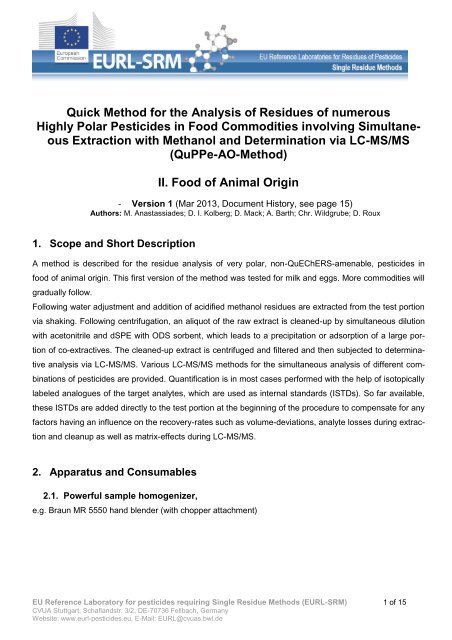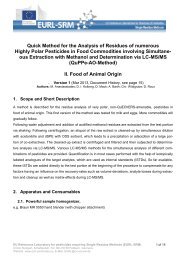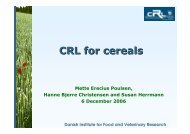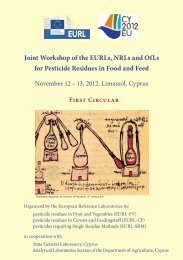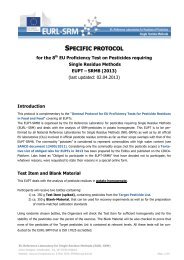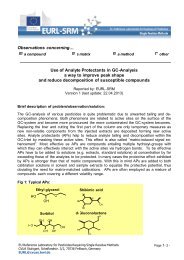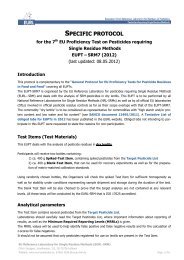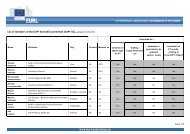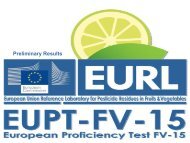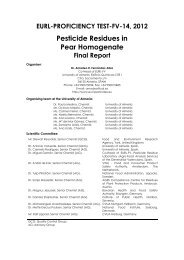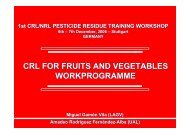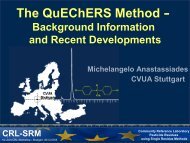QuPPe-AO - EURL | Residues of Pesticides
QuPPe-AO - EURL | Residues of Pesticides
QuPPe-AO - EURL | Residues of Pesticides
You also want an ePaper? Increase the reach of your titles
YUMPU automatically turns print PDFs into web optimized ePapers that Google loves.
Quick Method for the Analysis <strong>of</strong> <strong>Residues</strong> <strong>of</strong> numerous<br />
Highly Polar <strong>Pesticides</strong> in Food Commodities involving Simultaneous<br />
Extraction with Methanol and Determination via LC-MS/MS<br />
(<strong>QuPPe</strong>-<strong>AO</strong>-Method)<br />
II. Food <strong>of</strong> Animal Origin<br />
- Version 1 (Mar 2013, Document History, see page 15)<br />
Authors: M. Anastassiades; D. I. Kolberg; D. Mack; A. Barth; Chr. Wildgrube; D. Roux<br />
1. Scope and Short Description<br />
A method is described for the residue analysis <strong>of</strong> very polar, non-QuEChERS-amenable, pesticides in<br />
food <strong>of</strong> animal origin. This first version <strong>of</strong> the method was tested for milk and eggs. More commodities will<br />
gradually follow.<br />
Following water adjustment and addition <strong>of</strong> acidified methanol residues are extracted from the test portion<br />
via shaking. Following centrifugation, an aliquot <strong>of</strong> the raw extract is cleaned-up by simultaneous dilution<br />
with acetonitrile and dSPE with ODS sorbent, which leads to a precipitation or adsorption <strong>of</strong> a large por-<br />
tion <strong>of</strong> co-extractives. The cleaned-up extract is centrifuged and filtered and then subjected to determina-<br />
tive analysis via LC-MS/MS. Various LC-MS/MS methods for the simultaneous analysis <strong>of</strong> different com-<br />
binations <strong>of</strong> pesticides are provided. Quantification is in most cases performed with the help <strong>of</strong> isotopically<br />
labeled analogues <strong>of</strong> the target analytes, which are used as internal standards (ISTDs). So far available,<br />
these ISTDs are added directly to the test portion at the beginning <strong>of</strong> the procedure to compensate for any<br />
factors having an influence on the recovery-rates such as volume-deviations, analyte losses during extrac-<br />
tion and cleanup as well as matrix-effects during LC-MS/MS.<br />
2. Apparatus and Consumables<br />
2.1. Powerful sample homogenizer,<br />
e.g. Braun MR 5550 hand blender (with chopper attachment)<br />
EU Reference Laboratory for pesticides requiring Single Residue Methods (<strong>EURL</strong>-SRM)<br />
CVUA Stuttgart, Schaflandstr. 3/2, DE-70736 Fellbach, Germany<br />
Website: www.eurl-pesticides.eu, E-Mail: <strong>EURL</strong>@cvuas.bwl.de<br />
1 <strong>of</strong> 15
2.2. 50 mL centrifuge tubes with screw caps,<br />
for the extraction step (5.2.1), e.g.: a) disposable 50 mL centrifuge tubes (e.g. Sarstedt / Nümbrecht,<br />
Germany, 114x28 mm, PP, article-no. 62.548.004) or b) reusable 50 mL Teflon® centrifuge tubes with<br />
screw caps (e.g. Nalgene/Rochester, USA; Oak-ridge, article-no. 3114-0050).<br />
2.3. 10 mL centrifuge tubes with screw caps,<br />
For the d-SPE step (5.2.6), e.g.: disposable 10 mL PP-tubes by Simport/Beloeil (Canada), article-no.<br />
T550-10AT<br />
2.4. Automatic pipettes,<br />
suitable for handling volumes <strong>of</strong> 10 to 100 μl, 200 to 1000 μl and 1 to 10 ml.<br />
2.5. 10 mL solvent-dispenser,<br />
for the acidified methanol (3.6).<br />
2.6. Centrifuge,<br />
suitable for the centrifuge tubes employed in the procedure (2.2) and capable <strong>of</strong> achieving > 3000 g.<br />
2.7. Syringe filters,<br />
e.g. polyester filters 0.45 µm pore size.<br />
2.8. Syringes<br />
e.g. 2 or 5 mL disposable polypropylene syringes suitable for the above mentioned filters 2.7.<br />
2.9. Autosampler vials,<br />
suitable for LC auto-samplers,<br />
Use plastic vials if pesticides that tend to interact with glass-surfaces are present (e.g. Glyphosate and<br />
Ethephon) 1 .<br />
Note:<br />
- Such interaction with glass surfaces are more pronounced when solutions have low water content<br />
and low acidity.<br />
1 The list <strong>of</strong> compounds requiring plastic vessels might not be comprehensive (this remark applies to the entire doc-<br />
ument)<br />
EU Reference Laboratory for pesticides requiring Single Residue Methods (<strong>EURL</strong>-SRM)<br />
CVUA Stuttgart, Schaflandstr. 3/2, DE-70736 Fellbach, Germany<br />
Website: www.eurl-pesticides.eu, E-Mail: <strong>EURL</strong>@cvuas.bwl.de<br />
2 <strong>of</strong> 15
2.10. Volumetric flask with stoppers,<br />
for the preparation <strong>of</strong> stock and working solutions (3.11 - 3.16), e.g. 20 mL; 25 mL; 50 mL, 100 mL glass<br />
flasks. Use plastic flasks and stoppers if pesticides that tend to interact with glass-surfaces are present<br />
(e.g. Glyphosate and Ethephon).<br />
2.11. LC-MS/MS instrumentation,<br />
See latest version <strong>of</strong> <strong>QuPPe</strong>-PO-Method<br />
3. Chemicals<br />
Unless otherwise specified, use reagents <strong>of</strong> recognized analytical grade. Take every precaution to avoid<br />
possible contamination <strong>of</strong> water, solvents, sorbents, inorganic salts, etc.<br />
3.1. Water (deionized)<br />
3.2. Methanol (HPLC quality)<br />
3.3. Acetonitrile (HPLC quality)<br />
3.4. Formic acid (concentrated; > 95%)<br />
3.5. Acetic Acid (concentrated; >98%)<br />
3.6. Acidified methanol,<br />
pipette 10 mL formic acid (3.4) in a 1000 mL volumetric flask and fill up to volume with methanol (3.2).<br />
3.7. ODS (octadecylsilane) sorbent,<br />
e.g. Polygoprep 30-300 µm Macherey-Nagel GmbH & Co KG/Düren (Germany), article-no. 711720.100).<br />
3.8. Ammonium formate (p.a.)<br />
for the LC-MS/MS eluent in Method M4<br />
3.9. LC-MS/MS mobile phases<br />
See latest version <strong>of</strong> <strong>QuPPe</strong>-PO-Method.<br />
3.10. Pesticide Standards,<br />
<strong>of</strong> known purity.<br />
EU Reference Laboratory for pesticides requiring Single Residue Methods (<strong>EURL</strong>-SRM)<br />
CVUA Stuttgart, Schaflandstr. 3/2, DE-70736 Fellbach, Germany<br />
Website: www.eurl-pesticides.eu, E-Mail: <strong>EURL</strong>@cvuas.bwl.de<br />
3 <strong>of</strong> 15
3.11. Pesticide stock solutions,<br />
See latest version <strong>of</strong> <strong>QuPPe</strong>-PO-Method. Use plastic flasks and stoppers if pesticides that tend to interact<br />
with glass-surfaces are present (e.g. Glyphosate, Ethephon).<br />
3.12. Pesticide working solutions / mixtures,<br />
See latest version <strong>of</strong> <strong>QuPPe</strong>-PO-Method. Use plastic flasks and stoppers if pesticides that tend to interact<br />
with glass-surfaces are present (e.g. Glyphosate, Ethephon).<br />
3.13. Internal Standards (ISTDs),<br />
See latest version <strong>of</strong> <strong>QuPPe</strong>-PO-Method.<br />
3.14. ISTD Stock solutions,<br />
See latest version <strong>of</strong> <strong>QuPPe</strong>-PO-Method. Use plastic flasks and stoppers if pesticides that tend to interact<br />
with glass-surfaces are present (e.g. isotope labeled Glyphosate, Ethephon).<br />
3.15. ISTD-working solution I (ISTD-WS I) for spiking samples prior to extraction,<br />
See latest version <strong>of</strong> <strong>QuPPe</strong>-PO-Method. Use plastic flasks and stoppers if pesticides that tend to interact<br />
with glass-surfaces are present (e.g. isotope labeled Glyphosate, Ethephon).<br />
3.16. ISTD-working solution II (ISTD-WS II) for preparation <strong>of</strong> calibration standards,<br />
See latest version <strong>of</strong> <strong>QuPPe</strong>-PO-Method. Use plastic flasks and stoppers if pesticides that tend to interact<br />
with glass-surfaces are present (e.g. isotope labeled Glyphosate, Ethephon).<br />
4. Disclaimer<br />
This method refers to several trade name products and instruments which are commercially available and<br />
suitable for the described procedure. This information is given for the convenience <strong>of</strong> the users <strong>of</strong> this<br />
method and does not constitute an endorsement by the <strong>EURL</strong> <strong>of</strong> the products named. The application <strong>of</strong><br />
this method may involve hazardous materials, operations and equipment. It is the responsibility <strong>of</strong> the us-<br />
ers <strong>of</strong> this method to establish appropriate safety and health practices prior to use.<br />
EU Reference Laboratory for pesticides requiring Single Residue Methods (<strong>EURL</strong>-SRM)<br />
CVUA Stuttgart, Schaflandstr. 3/2, DE-70736 Fellbach, Germany<br />
Website: www.eurl-pesticides.eu, E-Mail: <strong>EURL</strong>@cvuas.bwl.de<br />
4 <strong>of</strong> 15
5. Procedure<br />
5.1. Sample preparation<br />
To obtain representative test-portions from the laboratory sample, proceed as required by the respective<br />
regulations and guidelines. Homogenize the eggs with a hand-blender (2.1) until a free flowing mixture is<br />
obtained. Proceed similarly with non-homogenized milk (e.g. if fat has separated).<br />
5.2. Extraction / Centrifugation / Filtration<br />
5.2.1. Weigh a representative portion (ma) <strong>of</strong> the sample homogenate (5.1) into a 50 mL centrifuge tube<br />
(2.2). In case <strong>of</strong> fresh milk and fresh eggs take 10 g 0.05 g <strong>of</strong> the homogenized sample.<br />
5.2.2. Add water (3.1) to a content <strong>of</strong> ca. 10 g in total. In the case <strong>of</strong> cow milk (88 % water) add 1.2 g <strong>of</strong><br />
water and in case <strong>of</strong> chicken eggs (76% water) add 2.4 g <strong>of</strong> water.<br />
Notes:<br />
- Where no IL-ISTDs are used or where they are added after extract aliquotation, water adjustment is<br />
essential. Where the appropriate IL-ISTDs are employed before any aliquotation has taken place<br />
water adjustment is less critical and can be skipped for commodities containing ≥80% water.<br />
5.2.3. Add 10 mL acidified methanol (3.6) and 50 µL <strong>of</strong> the ISTD-WS I (3.15) containing isotopically la-<br />
beled analogues <strong>of</strong> one or more <strong>of</strong> the analytes <strong>of</strong> interest (added ISTD mass = mISTD sample ).<br />
Notes:<br />
- For screening purposes the ISTD can be alternatively added to an aliquot <strong>of</strong> the final sample extract<br />
(see 5.2.10)<br />
5.2.4. Close the tube and shake vigorously for 1 min by hand or for 5-20 minutes by a mechanical shaker.<br />
5.2.5. Centrifuge for 5 min at >3000 g.<br />
5.2.6.Transfer a 2 mL aliquot into a 10 mL centrifuge tube with screw cap (2.3), which already contains the<br />
2 mL <strong>of</strong> acetonitrile (3.3) and 100 mg <strong>of</strong> ODS sorbent (3.7).<br />
5.2.7. Close the tube and shake vigorously for 1 min by hand.<br />
5.2.8. Centrifuge (e.g. for 5 min at >3000 g).<br />
5.2.9.Filter an aliquot (ca. 3-4 mL) <strong>of</strong> the extract through a syringe filter (2.7) into a sealable storage ves-<br />
sel.<br />
5.2.10. Transfer, as required, one or more aliquots (e.g. 1 mL each) into auto-sampler vials (2.9)<br />
Notes:<br />
- The cleaned-up extract will contain ca. 0.25 g sample equivalents per mL extract (if 10 g sample<br />
are employed for extraction).<br />
- Instead <strong>of</strong> adding the ISTD at the beginning <strong>of</strong> the procedure it can be added to an aliquot (e.g. 1<br />
mL) <strong>of</strong> the final sample extract. This way the added amount <strong>of</strong> ISTD per sample can be drastically<br />
reduced (e.g. 40-fold if added to 1 mL extract). The ISTD added at this step will compensate for ma-<br />
EU Reference Laboratory for pesticides requiring Single Residue Methods (<strong>EURL</strong>-SRM)<br />
CVUA Stuttgart, Schaflandstr. 3/2, DE-70736 Fellbach, Germany<br />
Website: www.eurl-pesticides.eu, E-Mail: <strong>EURL</strong>@cvuas.bwl.de<br />
5 <strong>of</strong> 15
5.3. Blank extracts<br />
trix effects including retention-time shifts. The quantitative result should however be considered as<br />
tentative. For more accuracy samples should be re-analyzed with the ISTD being added in step<br />
5.2.3.<br />
Using suitable blank commodities (not containing any detectable residues <strong>of</strong> the analytes <strong>of</strong> interest), pro-<br />
ceed sample preparation exactly as described under 5.2 but SKIP THE ADDITION OF ISTDs.<br />
5.4. Recovery experiments<br />
See latest version <strong>of</strong> <strong>QuPPe</strong>-PO-Method.<br />
5.5. Preparation <strong>of</strong> calibration standards<br />
5.5.1. Solvent-based calibration standards<br />
An exemplary pipetting scheme for the preparation <strong>of</strong> solvent-based calibration standards is shown in Ta-<br />
ble 1. The calculation <strong>of</strong> the mass-fraction WR <strong>of</strong> the pesticide in the sample, when ISTD is used, is shown<br />
in 5.7.1.<br />
Note:<br />
- Where solvent-based calibrations are used the use <strong>of</strong> IL-ISTDs for quantification is essential as the<br />
ISTD compensates for any matrix-related signal suppressions / enhancements.<br />
5.5.2.Matrix matched calibration standards<br />
Transfer suitable aliquots <strong>of</strong> the blank extract (5.3) to auto-sampler vials and proceed as shown in Table<br />
1.<br />
The calculation <strong>of</strong> the mass-fraction WR <strong>of</strong> the pesticide in the sample using matrix-matched calibration<br />
standards, with and without the use <strong>of</strong> ISTD, is shown in 5.7.1 and 5.7.2.1 respectively.<br />
EU Reference Laboratory for pesticides requiring Single Residue Methods (<strong>EURL</strong>-SRM)<br />
CVUA Stuttgart, Schaflandstr. 3/2, DE-70736 Fellbach, Germany<br />
Website: www.eurl-pesticides.eu, E-Mail: <strong>EURL</strong>@cvuas.bwl.de<br />
6 <strong>of</strong> 15
Table 1: Exemplary pipetting scheme for the preparation <strong>of</strong> calibration standards<br />
Calibration levels<br />
in µg pesticide /mL OR<br />
in µg pesticide/ “ISTD-portion”<br />
2<br />
Corresponding conc. in<br />
sample using 10 g test<br />
portions (mg/kg)<br />
Calibration standards<br />
Solvent based (5.5.1) Matrix-matched (5.5.2)<br />
using ISTD 1 without ISTD 5 using ISTD 1<br />
0.0125 0.025 0.0625 0.0125 0.025 0.0625 0.0125 0.025 0.0625<br />
0.05 0.1 0.25 0.05 0.1 0.25 0.05 0.1 0.25<br />
Pipetting Volumes<br />
Blank extract (5.3) - - - 875 µL 875 µL 875 µL 825 µL 825 µL 825 µL<br />
1:1 (v/v) mix <strong>of</strong> water (3.1)<br />
and acidified MeOH (3.6)<br />
Pesticide working<br />
solutions<br />
(3.12) 3<br />
925 µL 900 µL 825 µL 100 µL 75 µL - 100 µL 75 µL -<br />
0.5 µg/mL 25 µL 50 µL 125 µL 25 µL 50 µl 125 µL 25 µL 50 µL 125 µL<br />
ISTD-WS II (3.16) 2,4 50 µL 50 µL 50 µL - - - 50 µL 50 µL 50 µL<br />
Total volume 1000 µL 1000 µL 1000 µL 1000 µL 1000 µL 1000 µL 1000 µL 1000 µL 1000 µL<br />
1 When employing IL-ISTDs matrix-matching and volume adjustments are <strong>of</strong> less importance as the ISTD compensates<br />
for any matrix-related signal suppressions / enhancements. Also solvent-based calibrations can be used here.<br />
Important is that a) the mass ratio <strong>of</strong> pesticide and ISTD in the respective calibration standards and b) the ratio between<br />
the ISTD mass added to the sample (5.2.3) and the ISTD mass added to the calibration standard(s) (5.5.1<br />
and 5.5.2) is known and recorded. For convenience the latter mass ratio should be kept constant throughout all calibration<br />
levels (e.g. at 40:1 when preparing calibration standards <strong>of</strong> 1 mL).<br />
2 One ISTD portion would correspond to the ISTD mass contained in 50 µL ISTD-WS II (the volume added to each<br />
calibration standard).<br />
3 The concentration <strong>of</strong> the pesticide working solution(s) should be sufficiently high to avoid excessive dilution <strong>of</strong> the<br />
blank extract which would result in matrix effect deviations.<br />
4 For calibration standards <strong>of</strong> 1 mL it is recommended to prepare the ISTD-WS II (3.16) by diluting 40-fold the ISTD-<br />
WS I (3.15). The same volume and pipette as in 5.2.3 can then be used for the preparation <strong>of</strong> the calibration standards.<br />
5 Where IL-ISTDs are not available/employed, matrix-matching via matrix-matched standards (Table 1) or the standard<br />
additions approach (5.5.3) are particularly important to compensate for matrix effects in measurement. In both<br />
cases the final extract is assumed to contain 0.25 g sample/mL (when 10 g sample are used).<br />
EU Reference Laboratory for pesticides requiring Single Residue Methods (<strong>EURL</strong>-SRM)<br />
CVUA Stuttgart, Schaflandstr. 3/2, DE-70736 Fellbach, Germany<br />
Website: www.eurl-pesticides.eu, E-Mail: <strong>EURL</strong>@cvuas.bwl.de<br />
7 <strong>of</strong> 15
5.5.3.Standard-Additions-Approach<br />
Where no appropriate ISTDs are available the method <strong>of</strong> standard additions is a very effective approach<br />
for compensating matrix-induced enhancement or suppression phenomena. As this procedure involves a<br />
linear extrapolation it is mandatory that pesticide concentrations and detection signals show a linear rela-<br />
tionship throughout the relevant concentration range. The procedure furthermore requires knowledge <strong>of</strong><br />
the approximate (estimated) residue level in the sample (wR(exp.)) as derived from a preliminary analysis.<br />
Prepare 4 vials containing equal portions <strong>of</strong> the final extract. Three <strong>of</strong> them should be spiked with increas-<br />
ing amounts <strong>of</strong> the analyte. The amounts to be added should be chosen to be close to the expected<br />
amount <strong>of</strong> the analytes in the aliquots<br />
aliquot<br />
m pest(exp<br />
.)<br />
. It is important to remain within the linear range. Prepare a<br />
working solution (3.12) <strong>of</strong> the analyte at a concentration level where e.g. 50 or 100 µL <strong>of</strong> the solution con-<br />
tain the smallest amount <strong>of</strong> analyte to be added. Below some examples <strong>of</strong> standard additions:<br />
aliquot<br />
aliquot<br />
aliquot<br />
Example A: Vial 1) no addition; vial 2) 0.5 x m pest(exp<br />
.) , vial 3) 1 x m pest(exp<br />
.) , and vial 4) 1.5 x m pest(exp<br />
.) ,<br />
aliquot<br />
aliquot<br />
aliquot<br />
Example B: Vial 1) no addition; vial 2) 1 x m pest(exp<br />
.) , vial 3) 2 x m pest(exp<br />
.) , and vial 4) 3 x m pest(exp<br />
.) .<br />
Adjust the volume within all vials by adding the corresponding solvent amounts.<br />
Table 2 shows a pipetting scheme following Example A. The calculation <strong>of</strong> the mass fraction <strong>of</strong> the pesti-<br />
cide in the sample wR is shown in 5.7.2.2.<br />
Table 2 : Exemplary pipetting scheme <strong>of</strong> a standard additions approach (for a sample extract containing 0.25 g<br />
sample equivalents per mL and an estimated residue level (wR(approx)) <strong>of</strong> 0.4 mg/kg (corresponds to 0.1 µg/mL)<br />
Additions Vial 1 Vial 2 Vial 3 Vial 4<br />
Volume <strong>of</strong> final sample extract<br />
1000 µl<br />
(= 0.25 g sample)<br />
1000 µl<br />
(= 0.25 g sample)<br />
1000 µl<br />
(= 0.25 g sample)<br />
EU Reference Laboratory for pesticides requiring Single Residue Methods (<strong>EURL</strong>-SRM)<br />
CVUA Stuttgart, Schaflandstr. 3/2, DE-70736 Fellbach, Germany<br />
Website: www.eurl-pesticides.eu, E-Mail: <strong>EURL</strong>@cvuas.bwl.de<br />
1000 µl<br />
(= 0.25 g sample)<br />
ISTD none none none none<br />
Added volume <strong>of</strong> pesticide working<br />
solution containing 1 µg/ml (3.12)<br />
std add<br />
Resulting mass ( m pest ) <strong>of</strong> pesticide<br />
added to each vial<br />
- 50 µl 100 µl 150 µl<br />
0.05 µg 0.1 µg 0.15 µg<br />
Volume <strong>of</strong> solvent 150 µl 100 µl 50 µl -<br />
Final volume 1150 µl 1150 µl 1150 µl 1150 µl<br />
8 <strong>of</strong> 15
5.6. LC-MS/MS Measurement Conditions<br />
Any suitable LC and MS/MS conditions including those proposed in the <strong>QuPPe</strong>-PO-Method may be used.<br />
For food <strong>of</strong> animal origin we have so far only tested method M 1.3 and M 4.<br />
5.6.1. Exemplary LC-MS/MS chromatograms (method M1.3)<br />
Figure 1: Chromatograms <strong>of</strong> Fosetyl, Maleic Hydrazide, HEPA, Ethephon, MPPA, Glyphosate, Glufosinate, N-<br />
Acetyl-Glufosinate, at 0.1 µg/mL in MeOH (with 1% formic acid).<br />
Fosetyl 109/ 81 T Maleic hydrazid 111/ 82 T HEPA 125/ 79 T Ethephon 143/ 107 T<br />
MPPA 151/ 63 T Glyphosate 168/ 63 T Glufosinate 180/ 63 T N-Acetyl-Glufosinate 222/ 63 T<br />
Figure 2: Chromatograms <strong>of</strong> Fosetyl, Maleic Hydrazide, HEPA, Ethephon, MPPA, Glyphosate, Glufosinate, N-<br />
Acetyl-Glufosinate, at 0.0125 µg/mL in whole cow’s milk extract.<br />
Fosetyl 109/63 Maleic hydrazid 111/82 HEPA 125/79 Ethephon 143/107<br />
MPPA 151/63 Glyphosate 168/63 Glufosinate 180/95 N-acetylglufosinate 222/136<br />
Figure 3: Chromatograms <strong>of</strong> Fosetyl-Al, Maleic Hydrazide, HEPA, Ethephon, MPPA, Glyphosate, Glufosinate, N-<br />
Acetyl-Glufosinate, at 0.0125 µg/mL in chicken eggs extract.<br />
EU Reference Laboratory for pesticides requiring Single Residue Methods (<strong>EURL</strong>-SRM)<br />
CVUA Stuttgart, Schaflandstr. 3/2, DE-70736 Fellbach, Germany<br />
Website: www.eurl-pesticides.eu, E-Mail: <strong>EURL</strong>@cvuas.bwl.de<br />
9 <strong>of</strong> 15
Fosetyl 109/63 Maleic hydrazide 111/82 HEPA 125/79 Ethephon 143/107<br />
MPPA 151/63 Glyphosate 168/63 Glufosinate 180/63 N-acetylglufosinate 222/136<br />
5.6.2. Exemplary LC-MS/MS chromatograms (method M4)<br />
Figure 4: Chromatograms <strong>of</strong> Trimethylsulfonium cation, Nereistoxin, Mepiquat, Chlormequat, Daminozide, Cyromazine,<br />
Difenzoquat at 0.1 µg/mL in MeOH (with 1% formic acid).<br />
Trimethylsulfonium 77 / 62 Nereistoxin 150/105 Mepiquat 114 / 58 Chlormequat 122 / 58<br />
Daminozide 161 / 143 Cyromazine 167/68 Difenzoquat 249 / 77<br />
EU Reference Laboratory for pesticides requiring Single Residue Methods (<strong>EURL</strong>-SRM)<br />
CVUA Stuttgart, Schaflandstr. 3/2, DE-70736 Fellbach, Germany<br />
Website: www.eurl-pesticides.eu, E-Mail: <strong>EURL</strong>@cvuas.bwl.de<br />
10 <strong>of</strong> 15
Figure 5: Chromatograms <strong>of</strong> Trimethylsulfonium cation, Nereistoxin, Mepiquat, Chlormequat, Daminozide, Cyromazine,<br />
Difenzoquat at 0.0125 µg/mL in whole cow’s milk extract.<br />
Trimethylsulfonium 77 / 62 Nereistoxin 150/105 Mepiquat 114 / 58 Chlormequat 122 / 58<br />
Daminozide 161 / 143 Cyromazine 167/.68 Difenzoquat 249 / 77<br />
Figure 6: Chromatograms <strong>of</strong> Trimethylsulfonium cation, Nereistoxin, Mepiquat, Chlormequat, Daminozide, Cyromazine,<br />
Difenzoquat at 0.0125 µg/mL in chicken eggs extract.<br />
Trimethylsulfonium 77 / 62 Nereistoxin 150/105 Mepiquat 114 / 58 Chlormequat 122 / 58<br />
Daminozide 161 / 143 Cyromazine 167/68 Difenzoquat 249 / 77<br />
EU Reference Laboratory for pesticides requiring Single Residue Methods (<strong>EURL</strong>-SRM)<br />
CVUA Stuttgart, Schaflandstr. 3/2, DE-70736 Fellbach, Germany<br />
Website: www.eurl-pesticides.eu, E-Mail: <strong>EURL</strong>@cvuas.bwl.de<br />
11 <strong>of</strong> 15
5.7. Calibration and Calculations<br />
5.7.1. Using ISTD<br />
5.7.1.1. Where ISTD is added to the sample before any aliquotation:<br />
Follow the latest version <strong>of</strong> <strong>QuPPe</strong>-PO-Method. To ensure similar concentration <strong>of</strong> the ISTD is sample<br />
extracts and calibration standards it is reasonable to prepare the calibration standards in such a way that<br />
the ratio mISTD sample / mISTD cal mix equals 40 (to account for the final volume <strong>of</strong> the raw extract <strong>of</strong> 20 mL and<br />
the 1:1 dilution during cleanup). The absolute masses <strong>of</strong> the ISTD-WS I and II do not need to be neces-<br />
sarily known.<br />
5.7.1.2. Where ISTD is added to an aliquot <strong>of</strong> the extract<br />
Follow the latest version <strong>of</strong> <strong>QuPPe</strong>-PO-Method. When adding the ISTD to an aliquot <strong>of</strong> the extract (e.g. 1<br />
mL) it is mandatory to know the exact concentration <strong>of</strong> matrix-equivalnts per mL extract. If water adjust-<br />
ment is done as described in 5.2.2, the total volume <strong>of</strong> the raw extract can be assumed to be exactly 20<br />
mL. Considering the 2-fold dilution during the cleanup step 1 mL sample extract will represent 1/40 th <strong>of</strong> the<br />
test portion (ma). The mass <strong>of</strong> the ISTD to be added to an aliquot (mISTD aliquot ) should be scaled according<br />
to the aliquot volume used (Valiquot) with the ISTD mass ratio (mISTD aliquot / mISTD cal mix ) being important for<br />
the calculation.<br />
5.7.2. Not using ISTD<br />
If no appropriate ISTDs are used it is <strong>of</strong> high importance to properly compensate for matrix effects. For the<br />
compensation <strong>of</strong> matrix effects matrix-matched calibrations (5.5.2) and the standard additions approach<br />
(5.5.3) are recommended. In both cases the assumption is made that the total volume <strong>of</strong> the raw sample<br />
extract is exactly 20 mL, which is then diluted by a factor <strong>of</strong> 2. Adjustment <strong>of</strong> the water content (and ex-<br />
tract volume) in the sample is thus paramount.<br />
5.7.2.1. Calculations when employing matrix-matched calibration without ISTD<br />
Follow the latest version <strong>of</strong> <strong>QuPPe</strong>-PO-Method.<br />
In the formula multiply Vend by two to account for the 2-fold dilution in the cleanup step.<br />
EU Reference Laboratory for pesticides requiring Single Residue Methods (<strong>EURL</strong>-SRM)<br />
CVUA Stuttgart, Schaflandstr. 3/2, DE-70736 Fellbach, Germany<br />
Website: www.eurl-pesticides.eu, E-Mail: <strong>EURL</strong>@cvuas.bwl.de<br />
12 <strong>of</strong> 15
5.7.2.2. Calculations when employing the standard additions approach<br />
The standard additions approach is the method <strong>of</strong> choice where no appropriate IL-ISTD is available. This<br />
approach typically compensates matrix effect better than matrix-matched calibrations (5.5.2). The mass<br />
fraction <strong>of</strong> the pesticide in the sample (wR) is calculated via linear regression as shown in the latest ver-<br />
sion <strong>of</strong> <strong>QuPPe</strong>-PO-Method.<br />
In the formula multiply Vend by two to account for the 2-fold dilution in the cleanup step.<br />
5.8. Validation Data<br />
5.8.1.Method 1.3 ( “Glyphosate & Co”)<br />
Table 3 : Recoveries <strong>of</strong> analytes <strong>of</strong> method M1.3 in milk and eggs.<br />
Compound ISTD used n<br />
Recovery 0.1 mg/kg<br />
in whole cow milk<br />
Recovery mean<br />
[%]<br />
RSD [%]<br />
Recovery 0.1 mg/kg<br />
in chicken eggs<br />
Recovery mean<br />
[%]<br />
EU Reference Laboratory for pesticides requiring Single Residue Methods (<strong>EURL</strong>-SRM)<br />
CVUA Stuttgart, Schaflandstr. 3/2, DE-70736 Fellbach, Germany<br />
Website: www.eurl-pesticides.eu, E-Mail: <strong>EURL</strong>@cvuas.bwl.de<br />
RSD [%]<br />
Fosetyl Yes 5 99 1.9 104 1.9<br />
Maleic hydrazide Yes 5 106 3.6 107 4.5<br />
HEPA Yes 5 105 1.2 102 3.2<br />
Ethephon Yes 5 99 4.0 114 4.4<br />
MPPA Yes 5 103 4.7 100 7.7<br />
Glyphosate Yes 5 196 9.6 117 1.0<br />
Glufosinate Yes 5 94 8.5 100 4.1<br />
N-Acetyl-Glufosinate Yes 5 103 1.9 104 3.0<br />
13 <strong>of</strong> 15
5.8.2. Method 4 (“Quats & Co”)<br />
Table 4 : Recoveries <strong>of</strong> analytes <strong>of</strong> Method M4 in milk and eggs.<br />
Trimethylsulfonium<br />
ISTD used n<br />
No, (matrix<br />
matched)<br />
Recovery 0.1 mg/kg<br />
in milk<br />
Recovery mean<br />
[%]<br />
RSD [%]<br />
Recovery 0.1 mg/kg<br />
in eggs<br />
Recovery mean<br />
[%]<br />
EU Reference Laboratory for pesticides requiring Single Residue Methods (<strong>EURL</strong>-SRM)<br />
CVUA Stuttgart, Schaflandstr. 3/2, DE-70736 Fellbach, Germany<br />
Website: www.eurl-pesticides.eu, E-Mail: <strong>EURL</strong>@cvuas.bwl.de<br />
RSD [%]<br />
5 99 0.7 90 1.1<br />
Nereistoxin Yes 5 98 1.8 98 2.8<br />
Mepiquat Yes 5 98 2.1 100 1.4<br />
Chlormequat Yes 5 102 1.5 98 1.7<br />
Daminozide Yes 5 90 3.7 91 7.2<br />
Cyromazine Yes 5 100 0.8 104 2.4<br />
Difenzoquat<br />
6. References<br />
No, (matrix<br />
matched)<br />
5 92 2.4 78 1.6<br />
Anastassiades, M and Mack, D (2008); New Developments in the Analysis <strong>of</strong> <strong>Pesticides</strong> Typically not Covered by<br />
Multiresidue Methods; European Pesticide Residue Workshop, EPRW 2008, Berlin, oral presentation O1, Book <strong>of</strong><br />
Abstracts<br />
Kolberg DI, Mack D, Anastassiades M, Hetmanski MT, Fussell RJ, Meijer T, Mol HG. Anal Bioanal Chem.<br />
404(8):2465-74 (2012); Development and independent laboratory validation <strong>of</strong> a simple method for the determination<br />
<strong>of</strong> paraquat and diquat in potato, cereals and pulses<br />
Alder L. and Startin J. R. (2005); Determination <strong>of</strong> Chlormequat and Mepiquat in Foods by Liquid Chromatography/Mass<br />
Spectrometry or Liquid Chromatography/Tandem Mass Spectrometry: Interlaboratory Study; Journal <strong>of</strong><br />
<strong>AO</strong>AC International Vol. 88, No. 6: 1762-1776<br />
Vahl, M. et al. (1998); Analysis <strong>of</strong> Chlormequat residues in grain using liquid chromatography-mass spectrometry<br />
(LC-MS/MS); Fresenius J Anal Chem 361:817-820<br />
14 <strong>of</strong> 15
Table 5: Document History<br />
Action When? Version<br />
Development <strong>of</strong> Method by the <strong>EURL</strong>-SRM 2012 -<br />
Drafting <strong>of</strong> V1 2012-2013<br />
Placing <strong>of</strong> V1 in <strong>EURL</strong>-Website Feb. 2013<br />
EU Reference Laboratory for pesticides requiring Single Residue Methods (<strong>EURL</strong>-SRM)<br />
CVUA Stuttgart, Schaflandstr. 3/2, DE-70736 Fellbach, Germany<br />
Website: www.eurl-pesticides.eu, E-Mail: <strong>EURL</strong>@cvuas.bwl.de<br />
V1<br />
15 <strong>of</strong> 15


